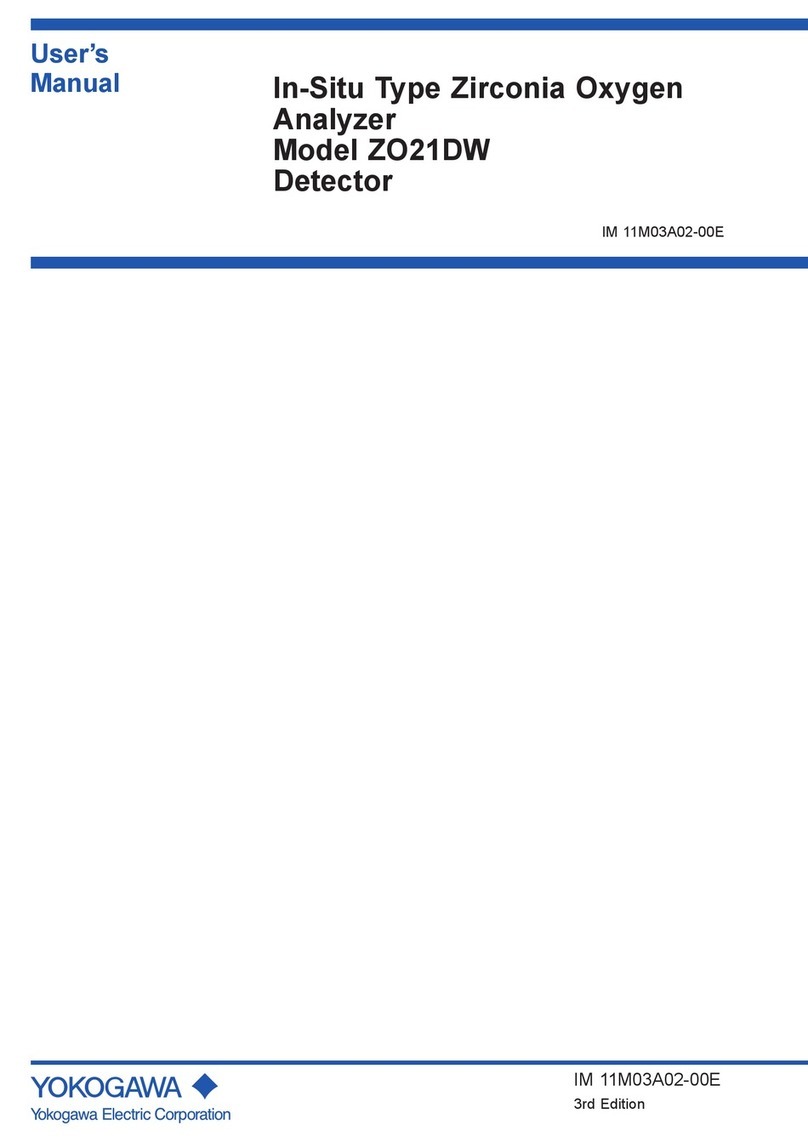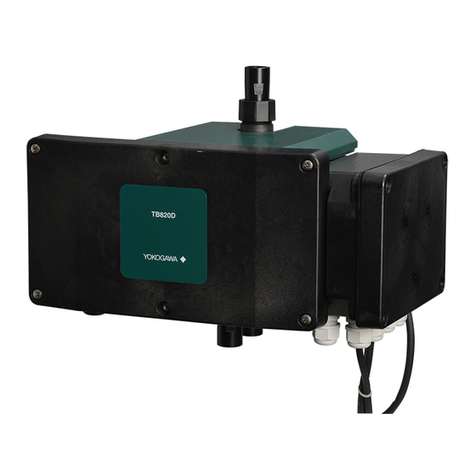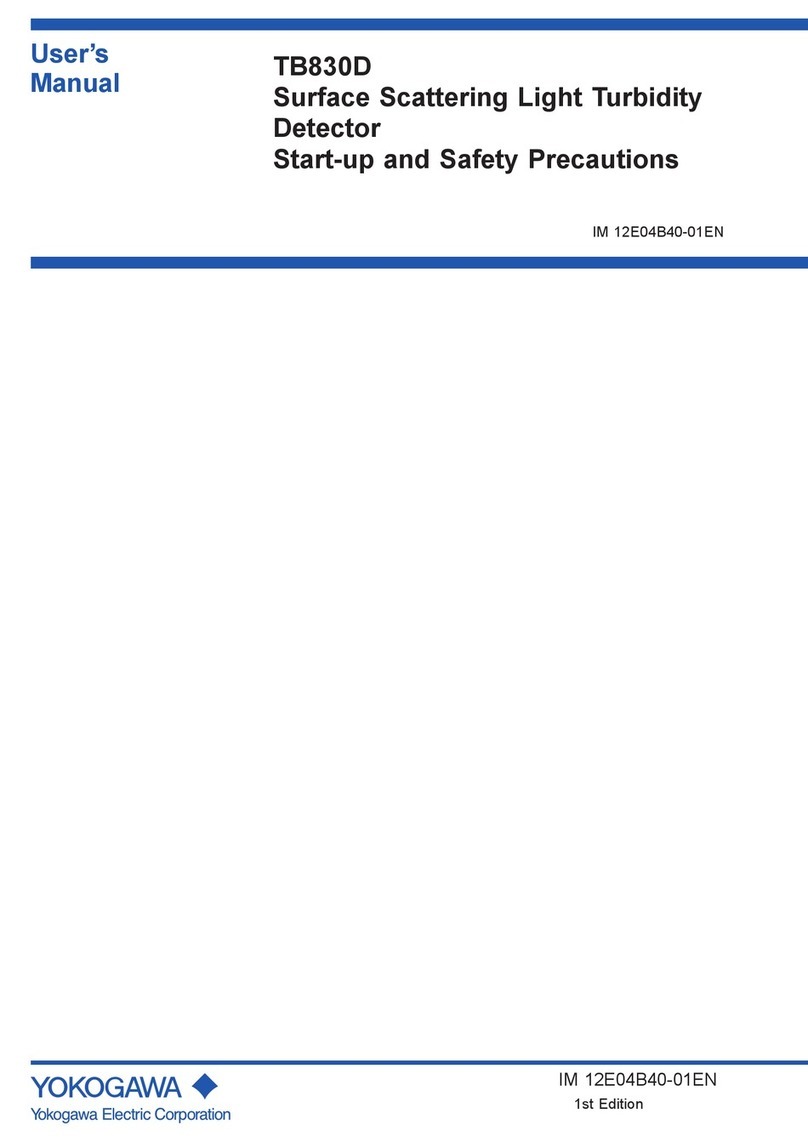
<1. OVERVIEW> 1-3
IM 12E04B40-02EN 1st Edition : Mar. 08, 2023-00
1.4 Model and Codes
n Model and Sux Codes
Model Sux code
Option
code
Description
TB830D ········································· ·········· Surface Scattering Light Turbidity Detector
Light source
and Turbidity
standard
-F8
-FS
··········
··········
White LED, Formazin, 0-2 NTU to 0-2000 NTU
860 nm, Formazin, 0-2 FNU/NTU to 0-2000 FNU/NTU
Type -AB
-AD
-AG
-AJ
··········
··········
··········
··········
General purpose for CE, RCM, China standard
General purpose for CSA
General purpose for KC
General purpose (*1)
Sampling system -NN
-A1
-A2
-A3
-A5
··········
··········
··········
··········
··········
Without sampling system (*2)
With sampling system (without automatic cleaning, without automatic
zero calibration) (*3) (*4) (*13)
With sampling system (with automatic cleaning, without automatic zero
calibration) (*3) (*14)
With sampling system (with automatic cleaning, with automatic zero
calibration) (*3) (*14)
Without sampling system, with relay box (*2)
Material and Connection of
Sampling system
-AN
-SN
-AD
-AB
-SD
-SB
··········
··········
··········
··········
··········
··········
Without sampling system (Detector mounting bracket Carbon steel) (*5)
Without sampling system (Detector mounting bracket Stainless steel) (*5)
Carbon steel stanchion, base mounting
Carbon steel stanchion, rear mounting
Stainless steel stanchion, base mounting
Stainless steel stanchion, rear mounting
Solenoid valve for Sampling
system
-NN
-10
-12
-20
-22
··········
··········
··········
··········
··········
Without Solenoid valve (*15)
100 V AC
110 V AC
200 V AC
220 V AC
—-NN ·········· Always -NN
—-NN ·········· Always -NN
Option /L02
/L03
/L05
/L10
/L20
/SCT
/U
/R
/CB
/CD
/CF
/ARS
/PHN7
/PHU7
/TT3
/FC
/PHN2
/PHU2
/L
Connection cable for analyzer 2 m (*6)
Connection cable for analyzer 3 m (*6)
Connection cable for analyzer 5 m (*6)
Connection cable for analyzer 10 m (*6)
Connection cable for analyzer 20 m (*6)
Stainless steel tag plate
Pipe mounting hardware (SUS)
Rack or wall mounting hardware (SUS)
Conduit adapter G1/2×1 pcs
Conduit adapter 1/2NPT× 1 pcs
Conduit adapter M20×1.5×1 pcs
With arrester (*7)
With pH (Using FLXA402) (without ultrasonic cleaning) (*8) (*10) (*13) (*14)
With pH (Using FLXA402) (with ultrasonic cleaning) (*8) (*10) (*13) (*14)
With 500ml KCl reserve tank for pH (*10) (*11)
With Free Available Chlorine Analyzer (*8) (*9) (*13) (*14)
With pH (Using FLXA402T 2nd input) (without ultrasonic cleaning) (*8)
(*11) (*13) (*14)
With pH (Using FLXA402T 2nd input) (with ultrasonic cleaning) (*8) (*11)
(*13) (*14)
Air denoising for Low Range (*12)
*1: “-AJ” is no standard.
*2: Install the head tank so that the ow rate of the detector is the specied ow rate (1.5 to 2 L/min). Customers have to
arrange a head tank.
*3: 1 μm zero turbidity lter is supplied with the product.
*4: Cleaning, zero calibration, span calibration are enabled manually.
*5: This is selectable only when Sampling system “-NN” or “-A5” is specied.
*6: This is not selectable when Sampling system “-A1”, “-A2”, “-A3” is specied. 1 m cable is supplied with the product. Select
this code for other cable length to change if necessary.
*7: This is not selectable when Type -AD is specied.
*8: This is selectable only when “-A1”, “-A2”, “-A3” for Sampling system is specied.
*9: For TB830D equipped with Non-reagent type Free Available Chlorine Analyzer. You need one converter just for the chlorine
analyzer. Selectable only when “-AJ” (no standard) is specied.
The TB830D cannot be equipped with both a pH sensor and a Non-reagent type Free Available Chlorine Analyzer.
Prepare the following products separately. Refer to GS 12F05B10-01EN for FC800D Non-reagent type Free Available
Chlorine Analyzer.
Sensor: FC800D-□□-AJ-NN-NN/L02/ST
Converter:
FLXA402T-A-B-AJ-CL-NN-N□-WR-N-□-J-ST-NN































